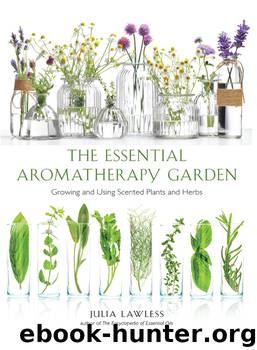Essential Aromatherapy Garden by Julia Lawless

Author:Julia Lawless
Language: eng
Format: epub
ISBN: 9781612834412
Publisher: Hampton Roads Publishing
Sweet-scented aquilegia (Aquilegia fragrans) is a great addition to a meadow.
In the seventeenth century, lawns were planted with chamomile or thyme (Thymus vulgaris, shown here).
A woodland area A number of scented plants are integral to woodlands, some so well loved that we could not imagine spring without them. Snowdrops and bluebells, violets, sweet woodruff and those most beautiful of plants, the Christmas or Lenten roses. One of the earliest plants in the winter garden that brings fragrance when there are still frosts and snow about is the honey-scented, delicate snowdrop. Happiest in dappled shade and humusrich moist soil, it is a hardy little plant, which steadily multiplies, especially the common European snowdrop, Galanthus nivalis: snowdrops are most dramatic planted in great sweeps under shrubs or trees. The double form G. n. ‘Flore Pleno’ flowers in late winter and early spring and is suitable for winter flower arrangements. G. elwesii, which comes from the Balkans and Turkey, is honey scented, as is the strongly scented G. ‘S. Arnott’, while G. allenii carries almond-scented flowers in the middle of winter. The earliest to flower is the autumn snowdrop, G. reginaeolgae and, around Christmas, G. gracilis carries flowers that smell of violets.
Evergreen hellebores look lovely alongside snowdrops; their dark leaves set off to perfection the snowy whiteness of their companions. Ideally suited to woodland planting, hellebores prefer dappled shade with moist soil and are fully to half hardy. The stinking hellebore (Helleborus foetidus) flowers in the late winter and early spring, carrying pale green bells edged in deep red. The variety ‘Miss Jekyll's Scented’ has a scent similar to lily-of-the-valley, as does the tender H. lividus, while the yellowish-green flowered H. odorus is also fragrant. The Christmas rose, H. niger, carries white flowers in the coldest months, as does the Lenten rose H. orientalis, although the latter flowers have little scent and can range in colour from ivory to the deepest maroon. Hellebores selfseed freely and should be divided in the autumn. Vita Sackville West wrote:
. . . perhaps there is nothing to equal the woodland acres of our native bluebell, smoke-blue as an autumn bonfire, heavy in scent as a summer rose, yet young as the spring which is its season.
(The Illustrated Garden Book)
In late spring, the fragrant bluebell carpets the woods, casting a violet-blue hue, which is especially lovely in light green beech woods. The English bluebell (Hyacinthoides non-scripta, syn. Endymion non-scripta) usually bears blue balsamic-scented, bell-like flowers, but they also occasionally produce pink or white flowers, as does the Spanish bluebell (H. hispanica), which carries larger flowers but is virtually unscented. Both species are prolific selfseeders and can be invasive in a border but are perfect for woodland settings. They are hardy and can be grown from bulbs planted out in the autumn. A semi-shaded site is best in moist soil; full sun will bleach out the intense blue of these delicate-looking plants.
Violets are very well suited to a woodland area, for they thrive in grassy areas under trees and like dappled shade.
Download
This site does not store any files on its server. We only index and link to content provided by other sites. Please contact the content providers to delete copyright contents if any and email us, we'll remove relevant links or contents immediately.
Turbulence by E. J. Noyes(7977)
The Thirst by Nesbo Jo(6877)
Gerald's Game by Stephen King(4607)
Be in a Treehouse by Pete Nelson(3996)
Marijuana Grower's Handbook by Ed Rosenthal(3640)
The Sprouting Book by Ann Wigmore(3561)
The Red Files by Lee Winter(3389)
The Remains of the Day by Kazuo Ishiguro(3343)
Sharp Objects: A Novel by Gillian Flynn(2983)
Christian (The Protectors Book 1) by L. Ann Marie(2669)
Organic Mushroom Farming and Mycoremediation by Tradd Cotter(2660)
The Culinary Herbal by Susan Belsinger(2451)
Stone Building by Kevin Gardner(2371)
The Starter Garden Handbook by Alice Mary Alvrez(2307)
Lilac Girls by Martha Hall Kelly(2271)
The Unlikely Pilgrimage of Harold Fry by Rachel Joyce(2241)
The Lean Farm Guide to Growing Vegetables: More In-Depth Lean Techniques for Efficient Organic Production by Ben Hartman(2106)
Urban Farming by Thomas Fox(2083)
Backyard Woodland by Josh VanBrakle(1909)
